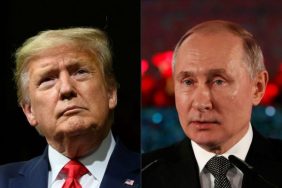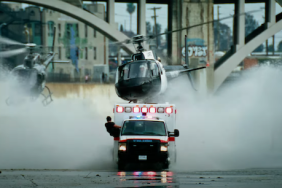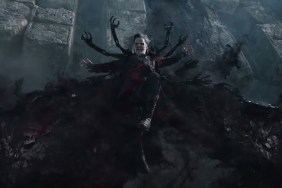“Rumors, rumors. Just rumors.” That’s what writer/director David Ayer told me about the Suicide Squad movie that would be confirmed by Warner Bros. just a few days later. So we know the Fury filmmaker can play things close to the vest. But otherwise he’s very open and candid when talking about the World War II drama about a tank crew invading Germany in the waning days of the conflict.
A little too candid, maybe. SPOILER ALERT: David Ayer talks about the death of one of the characters in Fury over the course of this interview. But he also talks about his personal obsession with historical accuracy, what the horses symbolize over the course of the film, the difference between European WWII movies and their American counterparts, where the name “Wardaddy” comes from and the “intense” romantic comedy he has in him somewhere.
David Ayer also describes the brain-spilling sequence he cut from the movie, because even the director of one of the most violent war movies ever made thought it was too much, in this CraveOnline exclusive interview.
Related: What’s the Best World War II Movie Ever?
CraveOnline: Your style before this seemed kind of run-and-gun, but in Fury it must have required a lot of prep before practically everything.
David Ayer: Yeah, exactly.
Was that difficult to wrap your head around? Is that how you prefer to work now?
No. This is a bigger canvas and it’s a bigger world. If you’re going to make a World War II movie you can’t just throw a camera on your shoulder and run into the streets and do it. Everything on screen has to be thought out, so every location, every uniform, vehicles, tanks, locations, etc. Everything has to be period accurate, so you have to think about the world you’re building and you have to think about how you’re going to show that world. For me it was great to just, not necessarily slow down because we were fast, but to think about how to compose the shots and what you’re saying. To paint a picture. We shot on film. We shot on anamorphic [with] traditional equipment. I think you get typecast as a director…
People get worried you can’t do a different thing.
Yeah, so it ain’t a cop movie and it ain’t shaky-cam, I’ll tell you that.
Even just from the opening shot, it has this Lawrence of Arabia feel to it for a second. Right away it says, “David Ayer can be patient, and it will pay off at the end.”
[Laughs.]
Was that calculated or did it just seem like the right way to start the movie?
I’m not patient. [Laughs.] I’m not patient. No, that first image for me was always something… That was the very first thing that came to me, to make the movie. That was the first image that solidified in my head of what this movie needed to be, and what it was. This idea of this horse emerging from the mist, and not necessarily understanding where we are and when we are, and then it enters the graveyard of tanks, is really the story of the transition of cavalry to mechanized warfare. People don’t realize that the German army was like 80% horse-drawn, even at its most powerful in World War II. By the end of the war it was mostly horse-drawn, and there’s an innocence about a horse. A horse doesn’t know where it is. There’s a lot of symbolic dream language at play there.
Later in the film they talk about what they’ve done to all of those horses, and it made me think about how significant it was that they let that one horse go.
Exactly, and that’s all sort of a motif that goes through the film. This idea that the horse, for me, represents innocence. Wardaddy letting that horse going in the beginning is really foreshadowing his own death. That’s his soul. He’s freeing his soul. The horse and everything that happened represents the tragedy of it, but that actually happened. It was the Battle of Falaise in 1944, in August of ’44, and basically we slaughtered the German army as they were running out of France, retreating back into Germany. A lot of animals were hurt. It’s pretty heavy-duty stuff.
In the press conference you referred to people who were real sticklers for accuracy as “Rivet Counters.”
Yeah.
It sounds like you might actually be one. It sounds like you know your stuff. Would you describe yourself as a “Rivet Counter?”
I’ve been known to count rivets, absolutely. I probably wasn’t much fun to work with because I’d lose my mind over things being wrong on set and go to incredible lengths to get them right. We did everything from printing our own SS camouflage to duplicate it exactly, to fabricating tank parts. We sourced tank parts from all over the world to get them correct, all the details. Just even the ration boxes on the back of the tanks. All the printing on them is period accurate. On the ammunition cases we had the correct lead seals and we had inspection paper slips inside.
Would you have noticed that, if the lead seals were wrong? If you were watching this movie and you hadn’t made it?
[Thinks.] Possibly. Possibly. No detail is too small. And here’s the thing, no matter how hard you work, there’s mistakes.
Is there one that ticks you off, that you regret?
Is there one that ticks me off…
Every time you edit the movie you were like, “Ugh, that damn gun…?”
Hundreds of them that tick me off. Hundreds of small things that I see that other people don’t seem to see. That’s the director’s job, to be implacable, and you do your best. I went and corrected a couple signs in post with CG to clean them up and have them say the right thing. But no one would notice that stuff.
My dad would notice that stuff.
Exactly.
But you could have fooled me. I wouldn’t know what the details are. But even if the details are wrong, what I felt watching the movie was the immediacy of the traumatic experience of warfare, and I haven’t seen that captured very well in a lot of other movies. Are there other movies that have captured that, do you feel?
It’s interesting because if PTSD ever becomes a theme the movie will wear it on its sleeve and sort of declare that, but for me this is in a lot of ways about live PTSD. It’s about watching people be exposed to trauma and then deal with it and process it in real time. It’s about a family. I mean, it’s these brothers. It’s family. It’s a study of a family that happens to kill people for a living and drive a tank around, and how do these men deal with a horse? That was always the movie for me. The movie for me wasn’t your typical World War II movie about a famous battle. This is really an anonymous day on an obscure corner of the map in the last month of the war. It’s a time that no one has really talked about.
From a screenwriting perspective one of the things that intrigued me was, a lot of screenplays begin with a new member joining a team and a lot of things have to be explained to them. Often it’s about how they’re pure and are going to correct a lot of behavior. Here it’s about, “We need to destroy his soul as fast as possible or he’s going to get us killed.”
Exactly! Exactly.
There’s a scene where he won’t shoot a German in the back, and I’m like, “Is this the kind of movie where he’s actually supposed to do it, or are we going to find out the gun had no bullets in it?”
[Laughs.] Right. That actually hadn’t occurred to me. You’re right, I could have gone that route. Huh. [Laughs.]
I think it’s wise that you didn’t.
But that’s that false note stuff. I didn’t want any false notes. I didn’t want to make the movie safe for people. I think the war is brutal. War is tough. Those kind of things happen. There’s a famous trial during the war where some soldiers were court-martialed for executing prisoners, and there defense was, “Patton told us to do it.” [Laughs.]
Right. What are you going to do?
Right.
I’ve noticed in a lot of your films, whether they’re really realistic or broader like Sabotage, that it seems like you’re really interested in the reality and immediacy of the violence. And yet there’s a rumor that you’re going to be doing a superhero movie, and I can’t even picture what that would be like. Does that even interest you?
Rumors! Rumors. Just rumors.
But does that genre, even generally…
I can’t confirm anything.
Don’t confirm anything, just talk in general.
I think a good director can step outside of any genre. My thing is, I don’t want to get typecast as the cop movie shaky-cam guy, for instance. So I go and do a war movie with much more meditative photography. I think a good director can tackle any genre and over my career I would love to sort of check off the list.
What’s a David Ayer romantic comedy like?
Probably pretty fun and intense.
“Intense?”
Yeah. Intense romantic comedy.
I’d like to see that.
Like meeting the mother-in-law. Holy cow, imagine that. [Laughs.]
Were there films that you watched to see what you wanted to do, or didn’t want to do, that had been done in World War II cinema before?
Well, I feel like World War II movies… there’s such a genre convention. I tell people, “Hey, I’m going to make a World War II movie,” and they just kind of groan and roll their eyes, because everyone’s expecting the same stock characters, and the guy’s going to show a picture of the girlfriend and get shot. It’s just cliché after cliché with these things. So I didn’t really look at any American World War II movies. I looked at lot at European movies made immediately post-war, both in East and West Germany. Polish movies, a Polish movie Kanal about the Warsaw uprising. There’s a famous Russian movie, Come and See, made during the 80s in the Soviet era. It was fascinating. I looked at these movies and tried to figure out what they were saying, and all of them… The American movies are typically about a famous battle, and these movies were about people’s experience and how the war changed people.
Because they had to live with it. They didn’t go home and their home was fine.
We get to go home and Mom’s making apple pies, and they get to go home and the place is bombed and Mom’s digging stuff out of the rubble. There’s much more of a shadow, and that’s what I wanted to show. The shadow of war, how this family endures these horrible experiences which influence them, yet they’re still brothers in the middle of it.
You’ve said that Wardaddy has a backstory that you didn’t want to go into too much detail about. One thing you don’t mention, but I feel like I really want to know the answer, is why do they call him “Wardaddy” specifically?
Well, there was an American tank named “Wardaddy” that was captured by the Germans. There’s actually pictures of Germans doing ordinance trails with it, reverse-engineering it, stuff like that. But there was also nicknames. There was also some tank commanders who were nicknamed “Wardaddy.” So it’s a real wartime name. There’s a lot of stuff that’s sort of unconventional in the film but is all very period-accurate.
I notice that even though it’s his wartime name, I think you only mention it twice. You keep it to a minimum. Was that intentional? Did you think some audiences might snicker?
No, no. I didn’t really worry about that. Maybe that’s my problem as a filmmaker, is that I could have picked a safer name, like “Nazi Killer” or something.
The first time I heard “Wardaddy,” I thought, “I’m sure there’s historical context for that but it sounds like a name someone would have at an S&M club.”
[Laughs.] Exactly. But that’s the thing. It’s a little bit counterintuitive, and I believe in counterpoint. I’m not afraid of counterpoint. He’s such a tough bastard and yet the name is kind of interesting in that regard. At the end of the day the guys just call him “Don.”
Did you have an interior of the tank in segments on a sound stage the entire time, or were there ever any shots where they were actually in a real tank?
We shot everything, all the tank interiors… we built a set, a complete set on a gimbal with panels that could be removed. The turret moved, the cannon could fire and eject shells. All the machine guns worked. All the levers, switches, nobs. The radio worked. There’s a working radio in it. Everything worked that needed to work. We’d pull out… the panels all had numbers on them, so we’d pull out 2A and 2C and stick a camera in there and that would take us to lunch. It took us two hours to set up a shot in there. It was like watching paint dry. When we had to go work on that set it would feel like my soul was dying as I waited for them to get the shots set up. But the results are amazing. You can’t tell it’s a set.
That’s why I asked. I was going to ask if you had GoPros in a real tank, or…
No, if I had shot this like End of Watch I would have shot it all with exactly that methodology, with 5D’s and GoPros in a real tank. But the photography is so precise and so technical with these film cameras that we had to make it perfect.
Speaking of the tank, the piece of human face that Logan Lerman finds… whose face was that modeled after?
That’s Red’s face. It was a British actor we cast to play Red when there’s pictures of him, so we did a life cast of him and made a little piece of his face. [Laughs.]
Were there ever any scenes with him?
He was always just the guy who died before the movie opened. And it was tough. It was tough to engineer that and get that right, to feel the absence of someone you’ve never met and someone you’re never going to introduce the audience to.
Well, having his headless corpse in the tank with them for a while helps.
Yeah, that goes a long way. That goes a long way, exactly.
Was there ever a moment where you thought you were going too far with the violence, that people just weren’t going to handle this?
We had a shot of them lowering Red’s body onto a stretcher and it was a close-up of the back of his head, and his brains fall out onto the stretcher. I saw that in the assembly and I thought, “Eh, maybe we shouldn’t do that.”
Maybe it’s a little early.
We’d scoop his brain cavity. We had a paper cup and scoop this blood and brain mixture into it before each take. That was somebody’s job on set.
It sounds like this movie was almost entirely practical. Was there a lot of CG as well?
The CG is really about dust-hits, blood-hits, weapons effects. The tracers are CG based upon research footage. We went and shot on military bases. But for the most part real fire, real explosions. I think that the real physics that you get from doing it on set… when you go and do it in post and try to do a CG shot, you’re only guessing. Nothing beats real.
Last question: Fury II. When?
That would be a little complex. Maybe it’s a prequel. Maybe Norman loves the army and goes to the Korean War.
Haunted tank. Change genres entirely. You say you want to branch out…
I could do that.
William Bibbiani is the editor of CraveOnline’s Film Channel and the host of The B-Movies Podcast and The Blue Movies Podcast. Follow him on Twitter at @WilliamBibbiani.









